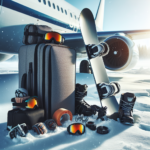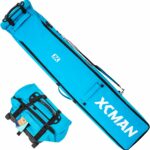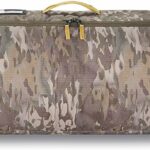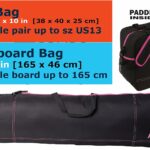Strapping on your snowboard and hitting the slopes is a thrilling experience that adrenaline junkies wouldn’t trade for anything. But what happens when the mountains call and you’re miles away with only a plane ticket between you and your snowy paradise? It might cross your mind, “how much is it to fly with a snowboard?” Navigating airlines and their respective policies could be quite puzzling, especially when it comes to those extra luggage fees. Let’s simplify that for you and shed some light on each airline’s snowboard transportation fees, so you can budget and plan your epic snowboarding getaway without any financial surprises.
Understanding Airline Policies for Snowboards
The first crucial step in your snowboarding trip preparation is to understand airline policies regarding snowboards. Each airline has its specific policies, and these may differ concerning dimensions, weight, and the number of snowboards allowed.
Looking into specific airline policies
Before you book your flight, look into the specific airline’s policies. Some airlines allow you to check your snowboard as a piece of regular luggage but some may require a special luggage category. Also, not checking their policy beforehand may result in last-minute surprises like handling fees or refusal of your snowboard on board.
Important considerations in airline policies
It’s important to take note of certain things while browsing through these policies. These may include weight restrictions, length restrictions, and the number of snowboards you are allowed to carry. It might also be good to check if the airline also includes your boots, bindings, and helmets in the same baggage or considers them separately.
Fees Associated with Flying with a Snowboard
Depending on your airline’s policy, you may or may not have to pay additional fees when flying with a snowboard.
Determining basic airline fees
The fee for carrying a snowboard can range anywhere from free to around $150, depending upon the airline. Some airlines count a snowboard as a regular checked bag, while others consider it oversized or special luggage. Therefore, it’s critical to check this with your airline before you start packing.
Special handling and oversize fees
You may also have to pay for special handling or oversized fees, especially if your snowboard bag exceeds the standard weight and size limit. Be sure to check your airline’s policy on this to avoid unexpected costs.
Packing a Snowboard for Flight
When it comes to packing, the goal is to keep your snowboard and gear safe during transportation.
Selecting an appropriate snowboard bag
Invest in a snowboard bag designed for travel. These bags provide padding to protect your board and straps to secure it and keep it from moving too much during transit.
Properly securing the snowboard in the bag
Place your board in the bag and secure it tightly with the straps. Make sure it is snug, so there is little-to-no movement inside the bag. You can also use your snowboarding clothing as additional padding.
Additional items to include in the snowboard bag
Consider packing additional items such as your snowboarding boots and helmet in the same bag. Not only can it be space-saving, but it may also save you from additional baggage fees if your airline allows.
Airport Procedures When Traveling with a Snowboard
Navigating the airport with a snowboard requires understanding certain procedures.
Checking-in the snowboard
At the airport, you’ll need to check in your snowboard at the airline’s desk or the designated special baggage area. Make sure to arrive a bit earlier as this process might take longer than usual.
Snowboard as carry-on luggage restrictions
Remember, most airlines won’t allow you to bring your snowboard as carry-on luggage due to its size.
Claiming the snowboard after the flight
After reaching your destination, you can retrieve your snowboard from the oversized or special luggage area.
Insurance Considerations when Flying with a Snowboard
Taking insurance when flying with a snowboard is another important consideration.
The necessity of travel insurance
Travel insurance is a safeguard for unforeseen circumstances. It helps to cover the cost if your snowboard gets damaged, lost or stolen during transit.
Ensure your insurance policy covers damage or loss of sports equipment or has an add-on option for the same. Also, make sure to keep all necessary documents like receipts and the airline’s report in case of damage or loss claim.
Pre-flight Preparations for Flying with a Snowboard
Prepare your snowboard for air travel to make the process smoother and minimize potential issues.
Checking airline restrictions ahead of time
Always check the airline’s restrictions on snowboard bags and equipment ahead of time. This includes any restrictions on size, weight, or special handling requirements.
Preparing a snowboard for flight travel
Ensure your snowboard is properly cleaned, dried, and wax-free. Remove any loose parts to prevent damage during flight and deflate the bindings to save space and weight in the snowboard bag.
Dealing with potential issues with airport security
Anticipate potential issues with airport security. Have clear answers about what’s in your snowboard bag to prevent unnecessary delays.
Possible Additional Costs When Flying with a Snowboard
You might have to face additional costs when you fly with a snowboard.
Additional handling fees
Some airlines may charge additional handling fees for snowboards.
Potential storage fees
If your flight gets delayed or you have a long layover, there might be storage fees involved at the airport.
Extra cost for overweight baggage
If your snowboard bag is overweight, you will likely have to pay extra.
Alternatives to Flying with a Snowboard
If you decide not to fly with your own snowboard, there are a couple of alternatives.
Renting a snowboard at the destination
Keep in mind that renting a snowboard at your destination can have its benefits. Not only will you save the hassle of traveling with it, but you might also have the opportunity to try out different boards.
Shipping the snowboard to the destination
You can also consider shipping your snowboard to your destination through a courier service. Just be sure to factor in the shipping time and costs.
Tips and Tricks for Flying with a Snowboard Hassle-Free
Flying with your snowboard doesn’t have to be a hassle if you plan well and follow these tips.
Maximizing space in the snowboard bag
Save space in your snowboard bag by placing small items like gloves and goggles inside your boots. You can also use your snowboarding apparel as additional padding to protect your board.
Protecting the snowboard during flight
Use pipe insulation or padding around the edges of your board to increase protection. Make sure to secure the bindings to prevent them from flapping around.
Case Studies: Experiences of People Flying with Snowboards
Finally, learning from the experiences of others can provide valuable insights.
Successful experiences of flying with a snowboard
Many people have had successful trips with their snowboards. They emphasized the importance of a proper snowboard bag, early arrival at the airport, and having a positive attitude.
Challenges faced and solutions used
Others have faced obstacles, like extra charges and damaged boards. Their solutions ranged from investing in quality travel insurance to packing and securing their snowboards more effectively.
Tips gathered from frequent flyers with snowboards
Frequent flyers suggest checking airline restrictions well in advance and using travel insurance. Also, being courteous with airline staff can make the process smoother.
In conclusion, flying with a snowboard might come with a few challenges, but with adequate knowledge and preparation, you can navigate through them like a pro. The freedom of gliding down the slopes with your own gear can make the extra effort all worth it. So, gear up and get ready to hit the pistes!
- What Snowboard Bindings Should I Get? - January 23, 2024
- What Size Screws For Snowboard Bindings? - January 23, 2024
- How To Snowmobile On Water? - January 23, 2024










